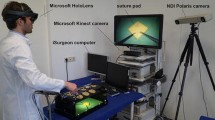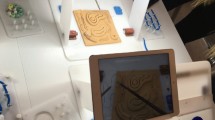Abstract
Background: A reliable method supplying graduated experience and practice is needed to develop and refine laparoscopic skills. The laparoscopic surgeon, like the microvascular surgeon, must have ongoing training to refine and maintain his or her skills.
Methods: The authors describe a new modular training unit. The unit consists of a box with a built-in television camera, a light source, and a rotating platform. A videotape recorder with a timing device documents the actual “operating time” required for the various exercises. The first phase of training consists of a basic skills board. This initial phase enhances the use of dominant and nondominant hand motor activity.
Results: The surgeon then progresses to lifelike models (biliary, suturing, hernia, gynecologic) to simulate the human operative setting. Ten surgeons spent 5 h each working with the module. The specific exercises were recorded and timed. Their progress is described.
Conclusions: The modular laparoscopic skills center is an integral part of any laparoscopic educational program. It facilitates the acquisition and maintenance of laparoscopic skills.
Similar content being viewed by others
References
Bailey RW, Imbembo AL, Zucker KL (1991) Establishment of a laparoscopic cholecystectomy training program. Am Surg 57: 231–236
Bohm B, Milsom JW (1994) Animal models as educational tools in laparoscopic colorectal surgery. Surg Endosc 8: 707–713
Capperauld L, Hargraves J (1991) Surgical simulation for general practitioners. Ann R Coll Surg Engl 73: 273–275
Coleman J, Nduka CC, Darzi A (1994) Virtual reality and laparoscopic surgery. Br J Surg 81: 1709–1711
Crosthwaite G, Chung T, Dunkley P, Shimi S, Cuschieri A (1995) Comparison of direct vision and electronic 2-D and 3-D display systems on surgical task efficiency in endoscopic surgery. Br J Surg (in press)
Cuschieri A (1993) Reflections on surgical training. Surg Endosc 7: 73–74
Dent TL (1992) Training credentialing, and evaluation in laparoscopic surgery. Surg Clin North Am 72: 1003–1010
Gees WP, Collate AV, Verdeja JC, Plasencia G, Ojogho O, Jacobs M (1994) Sequential psychomotor skills development in laparoscopic colon surgery. Arch Surg 129: 206–212
Hunter JG, Sackier JM, Berci G (1994) Training in laparoscopic cholecystectomy: quantifying the learning curve. Surg Endosc 8: 28–31
Mughal M (1992) A cheap laparoscopic surgery trainer. Ann R Coll Surg Engl 74: 256–257
Noar MD, Soehendra N (1992) Endoscopy simulation training devices. Endoscopy 24: 159–166
Pietrabissa A, Scarcello E, Carobbi A, Mosca F (1994) Three-dimensional versus two-dimensional video system for the trained endoscopic surgeon and the beginner. End Surg 2: 315–317
Sackier JM, Berci G, Paz-Partlow M (1991) A new training device for laparoscopic cholecystectomy. Surg Endosc 5: 158–159
Shapiro SJ, Gordon LA, Daykhovsky L, Senter N (1994) The laparoscopic hernia trainer: the role of a life-like trainer in laparoendoscopic education. End Surg 2: 66–68
Soper NJ, Hunter JG (1992) Suturing and knotting in laparoscopy. Surg Clin North Am 72: 139–152
Szabo Z, Hunter J, Berci G, Sackier J, Cuschieri A (1994) Analysis of surgical movements during suturing in laparoscopy. End Surg 2: 55–61
Wallwiener D, Rimbach S, Bastert G (1994) The Hystero trainer, a simulator for diagnostic and operative hysteroscopy. J Am Assoc Gynecol Laparoendosc 2: 61–63
Wolfe BM, Szabo Z, Moran ME, Chan P, Hunter JG (1993) Training for minimally invasive surgery: need for surgical skills. Surg Endosc 7: 93–95
Author information
Authors and Affiliations
Rights and permissions
About this article
Cite this article
Shapiro, S.J., Paz-Partlow, M., Daykhovsky, L. et al. The use of a modular skills center for the maintenance of laparoscopic skills. Surg Endosc 10, 816–819 (1996). https://doi.org/10.1007/BF00189541
Accepted:
Issue Date:
DOI: https://doi.org/10.1007/BF00189541




